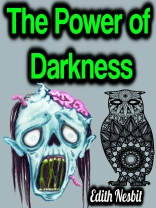The Power of Darkness Edith Nesbit – The Power of Darkness was written in the year 1905 by Edith Nesbit. This book is one of the most popular novels of Edith Nesbit, and has been translated into several other languages around the world. Plot Summary: The figure of my wife came in it came straight towards the bed, its wide eyes were open and looked at me with love unspeakable, Edith Nesbit, best known as the author of The Railway Children and other children’s classics, was also the mistress of the ghost story and tales of terror. She was able to create genuinely chilling narratives in which the returning dead feature strongly. Sadly, these stories have been neglected for many years, but now, at last, they are back in print. In this wonderful collection of eerie, flesh-creeping yarns, we encounter love that transcends the grave, reanimated corpses, vampiric vines, vengeful ghosts and other dark delights to make you feel fearful. These vintage spooky stories, tinged with horror, are told in a bold, forthright manner that makes them seem as fresh and unsettling as today’s headlines.
Om författaren
Edith Nesbit (married name Edith Bland; 15 August 1858 – 4 May 1924) was an English author and poet; she published her books for children under the name of E. Nesbit.
She wrote or collaborated on over 60 books of fiction for children, several of which have been adapted for film and television. She was also a political activist and co-founded the Fabian Society, a socialist organisation later connected to the Labour Party.
Edith Nesbit was born in Kennington, Surrey, the daughter of agricultural chemist and schoolmaster John Collis Nesbit. The death of her father when she was four and the continuing ill health of her sister meant that Nesbit had a transitory childhood, her family moving across Europe in search of healthy climates only to return to England for financial reasons. Nesbit therefore spent her childhood attaining an education from whatever sources were available—local grammars, the occasional boarding school but mainly through reading.
At 17 her family finally settled in London and aged 19, Nesbit met Hubert Bland, a political activist and writer. They became lovers and when Nesbit found she was pregnant they became engaged, marrying in April 1880. After this scandalous (for Victorian society) beginning, the marriage would be an unconventional one. Initially, the couple lived separately—Nesbit with her family and Bland with his mother and her live-in companion Maggie Doran.
Initially, Edith Nesbit books were novels meant for adults, including The Prophet’s Mantle (1885) and The Marden Mystery (1896) about the early days of the socialist movement. Written under the pen name of her third child ’Fabian Bland’, these books were not successful. Nesbit generated an income for the family by lecturing around the country on socialism and through her journalism (she was editor of the Fabian Society’s journal, Today).
In 1899 she had published The Adventures of the Treasure Seekers to great acclaim.












